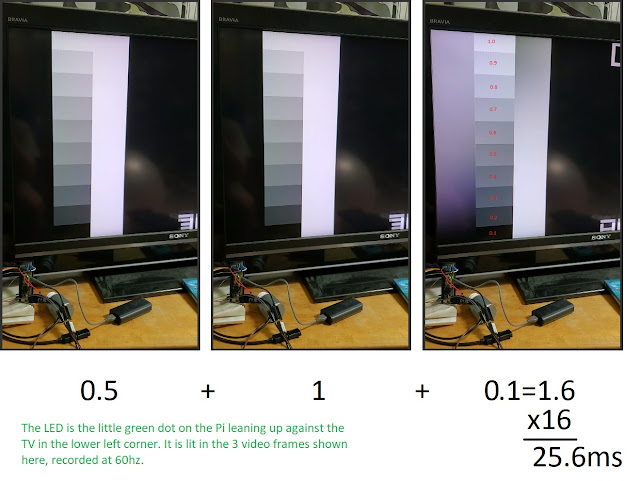Sony KDL-46EX400 HDTV: input lag / upscaling /deinterlacing review
This 46" HDTV dates back to 2010, with 2 component inputs + 4 HDMI, along with other inputs less useful for retro gamers. It's not a smart TV but it sure is cheap on the used market.
I've since redone this review with much fancier tools, and I suggest you read the new review instead. My older methods turned up basically the same results except that I didn't notice how input lag would vary by up to 16ms each time the tv was powered on (oops).
Image quality
Native resolution is 1080p. It's bright, sharp, and colorful. It has very little black crush. You can set 480p to be stretched to wide screen or maintain aspect ratio, which shows the full 480 pixels, with no cropping. Sadly the 480p upscaling is just a little bit blocky/aliased, though that's probably unavoidable.
Input lag (HDMI/480p), measured with a OSSC + 240fps highspeed camera
This TV has a B2W transition of about 5ms. So the input lag varies depending on whether you wait for the TV to reach a steady state (25ms) or measure the first moment that the screen responds to input (21ms).
How I measured: I used an OSSC outputting at 480p. The OSSC lights a LED the moment it starts transmitting the pixels of a white probe over a previously black background. Using a moderately fast high speed camera (Samsung S7, 240fps) you can measure the delay between the LED lighting and the probe appearing on the screen. Since the B2W transition takes some time, the probe gets brighter over 1 or sometimes 2 additional frames.
Side note: the OSSC measures lag in a somewhat unusual way: relative to the moment the probe pixels are sent over HDMI, rather than the start of the frame. To be consistent with other lag testers, I only tested in the upper-left where there is no distinction between methods. Painting the full frame would add an additional 16ms of lag.
Deinterlacing using OSSC
The OSSC uses bob deinterlacing for zero added lag (aka linedoubling). This looks a little better when you add temporally alternating light-dark scanlines which masks the inherent "bob" blockiness of doubling each scanline. The result looks good, but with darker scanlines lacing artifacts start to appear.
Built-in TV deinterlacing: lag and appearance
The OSSC can instead send the interlaced signal to the tv and let it deinterlace. This looks very good, better than bob. The cost is lag - an extra 33ms, for 58ms of total lag. That's two full frames, and enough you can feel it. But for a RPG the result is nice visuals. Still more blocky/blurry than a CRT though.
Without the OSSC
The TV comes with 2 component inputs. I didn't test them but I assume they are similar to letting the OSSC transcode from yPrPb to HDMI.
Without the remote
This has decently usable controls without the remote.
Other similar models
I would expect that the 40EX400 and 32EX400 would perform about the same as the 46EX400, based on the model numbers, and a quick skim of the specs (all are native 1080p displays). But I only tested the 46EX400. The 46EX401/40EX401 are supposedly the same model but at Costco.
Image quality
Native resolution is 1080p. It's bright, sharp, and colorful. It has very little black crush. You can set 480p to be stretched to wide screen or maintain aspect ratio, which shows the full 480 pixels, with no cropping. Sadly the 480p upscaling is just a little bit blocky/aliased, though that's probably unavoidable.
Input lag (HDMI/480p), measured with a OSSC + 240fps highspeed camera
This TV has a B2W transition of about 5ms. So the input lag varies depending on whether you wait for the TV to reach a steady state (25ms) or measure the first moment that the screen responds to input (21ms).
How I measured: I used an OSSC outputting at 480p. The OSSC lights a LED the moment it starts transmitting the pixels of a white probe over a previously black background. Using a moderately fast high speed camera (Samsung S7, 240fps) you can measure the delay between the LED lighting and the probe appearing on the screen. Since the B2W transition takes some time, the probe gets brighter over 1 or sometimes 2 additional frames.
Side note: the OSSC measures lag in a somewhat unusual way: relative to the moment the probe pixels are sent over HDMI, rather than the start of the frame. To be consistent with other lag testers, I only tested in the upper-left where there is no distinction between methods. Painting the full frame would add an additional 16ms of lag.
Deinterlacing using OSSC
The OSSC uses bob deinterlacing for zero added lag (aka linedoubling). This looks a little better when you add temporally alternating light-dark scanlines which masks the inherent "bob" blockiness of doubling each scanline. The result looks good, but with darker scanlines lacing artifacts start to appear.
Built-in TV deinterlacing: lag and appearance
The OSSC can instead send the interlaced signal to the tv and let it deinterlace. This looks very good, better than bob. The cost is lag - an extra 33ms, for 58ms of total lag. That's two full frames, and enough you can feel it. But for a RPG the result is nice visuals. Still more blocky/blurry than a CRT though.
Without the OSSC
The TV comes with 2 component inputs. I didn't test them but I assume they are similar to letting the OSSC transcode from yPrPb to HDMI.
Without the remote
This has decently usable controls without the remote.
Other similar models
I would expect that the 40EX400 and 32EX400 would perform about the same as the 46EX400, based on the model numbers, and a quick skim of the specs (all are native 1080p displays). But I only tested the 46EX400. The 46EX401/40EX401 are supposedly the same model but at Costco.



Comments